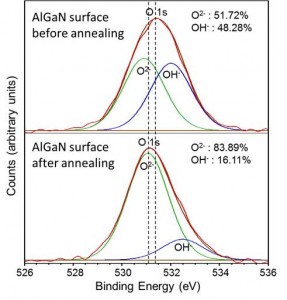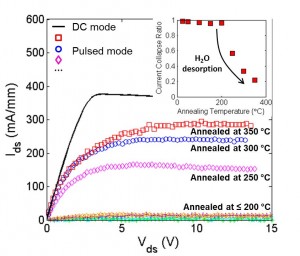On the Origin of Surface Trapping Effects in AlGaN/GaN HEMTs
- Category: Electronic Devices
- Tags: feng gao, tomas palacios
GaN-based high-electron-mobility transistors (HEMTs) are very promising candidates for the next generation of high-power and high-frequency electronics. However, trapping effects have been one of the most important barriers in the development of the GaN semiconductor since its infancy. In recent years, significant research efforts have been focused on understanding and suppressing trapping effects in AlGaN/GaN HEMTs[1]. Many of these effects have been linked to surface traps, and they have been mitigated by using passivation layers, such as silicon nitride[2]. The physical origin of these surface traps is, however, not clear yet. In this work, we propose that surface trapping effects in AlGaN/GaN HEMTs are mainly caused by water-related electron traps on the device’s surface.
First, we show that adsorbed water on the III-N surface cannot be fully removed by vacuum pumping at room temperature (RT). In fact, it is well known in SiO2 surface chemistry that hydrogen-bonded water monolayers cannot be removed by just pumping in a vacuum at RT. Thermal annealing in a vacuum above 200 °C is needed[3]. We thus carry out in-situ X-ray photoelectron spectroscopy (XPS) analysis on the AlGaN surface before and after the vacuum annealing. The sample was initially analyzed by XPS at RT, then annealed at 300 °C for an hour, cooled down to RT, and subsequently analyzed by XPS again without breaking the vacuum. The signature of the adsorbed water—hydroxyl group (OH–)–is significantly reduced on the AlGaN surface after the vacuum annealing at 300 °C.
Second, we conduct in-situ pulsed I-V measurements on unpassivated AlGaN/GaN HEMTs annealed at different temperatures in a vacuum to directly link the desorption process to the trapping transients, such as current collapse and dynamic on-resistance. By annealing them in a vacuum above 250 °C and subsequent in-situ pulsed I-V measurements at RT, we find that the current collapse and the dynamic on-resistance of unpassivated AlGaN/GaN HEMTs are significantly suppressed. Moreover, this behavior is reversible, which means that as soon as the AlGaN surface is exposed again to ambient air and re-adsorbs water molecules from moisture, the trapping transients return to their initial levels.
In conclusion, water molecules in ambient air are identified as the origin of the surface trapping effects, and we believe air moistureplays a key role in the dynamic on-resistance and drain current collapse of AlGaN/GaN HEMTs.
- Figure 1: In-situ XPS analysis of the O 1s core level on the AlGaN surface before and after 300 °C vacuum annealing for an hour.
- Figure 2: Ids vs. Vds in pulsed and DC mode at RT after in-situ vacuum annealing at different temperatures. Inset shows the current collapse ratio as a function of the annealing temperature. Pulse width is 250 ns.

